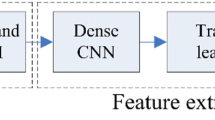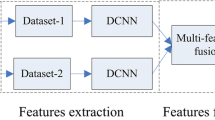Abstract
Aimed at the deficiency of traditional feature extraction techniques in radar emitter recognition, a novel deep feature extraction and recognition architecture is proposed. To fit into the model, the time-domain emitters are transformed into unique time-frequency images correspondingly. Since auto-encoders restrict the input data to be vector-form and convolutional model is hard to optimize, denoising auto-coders are stacked in a convolutional manner in the pre-training stage and the proposed framework is trained by greedy layer-wise algorithm. The optimized network parameters are employed to initialize convolutional neural networks. By layers of mapping and pooling, deep time-frequency features are extracted, which are fed into the collaborative representation-based classifier to implement classification task. Experimental results on simulated data validate the feasibility of the proposed architecture. Furthermore, compared with conventional shallow algorithms, the proposed one can obtain higher recognition accuracy and more robust performance. Taking advantage of collaborative representation, the proposed algorithm is more applicable to the small-sample-size case.






Similar content being viewed by others
References
M. Anthimopoulos, S. Christodoulidis, L. Ebner et al., Lung pattern classification for interstitial lung diseases using a deep convolutional neural network. IEEE Trans. Med. imaging 35(5), 1207–1216 (2016)
Y. Bengio, Learning deep architectures for AI. Found. Trends Mach. Learn. 2(1), 1–127 (2009)
Y.S. Chen, Z.H. Lin, X. Zhao et al., Deep learning-based classification of hyperspectral data. IEEE J. Sel. Top. Appl. Earth Obs. Remote Sens. 7(6), 2094–2107 (2014)
M.A.T. Figueiredo, R.D. Nowak, S.J. Wright, Gradient projection for sparse reconstruction: application to compressed sensing and other inverse problems. IEEE J. Sel. Top. Signal Process. 1(4), 586–597 (2007)
X. Guan, X. Yi, Y. He, A novel emitter signal recognition model based on rough set. Lect. Notes Control Inf. Sci. 345(1), 81–89 (2006)
X.B. Han, Y.F. Zhong, B. Zhao et al., Unsupervised hierarchical convolutional sparse auto-encoder for high spatial resolutional imagery scene classification, in International Conference on Natural Computation 15–17 Aug (2015), pp 42–46
S. Jia, L.L. Shen, Q.Q. Li, Gabor feature-based collaborative representation for hyperspectral imagery classification. IEEE Trans. Geosci. Remote Sens. 53(2), 1118–1129 (2015)
J. Lunden, V. Koivunen, Automatic radar waveform recognition. IEEE J. Sel. Top. Signal Process. 1(1), 124–136 (2007)
J. Lunden, L. Terho, V. Koivunen, Waveform recognition in pulse compression radar systems, in IEEE Workshop on Mach. Learn. for, Signal Process (2005), pp. 271–276
J. Ma, G.M. Huang, W. Zuo et al., Robust radar waveform recognition algorithm based on random projections and sparse classification. IET Radar Sonar Navig. 8(4), 290–296 (2014)
J. Masci, U. Meier, C. Dan et al., Stacked convolutional auto-encoders for hierarchical feature extraction, in Interantional Conference on Artificial Neural Network Espoo, Finland, June 14–17 (2011), pp. 52–59
J. Schmidhuber, Deep Learning in neural networks: an overview. Neural Netw. 61, 85–117 (2015)
C.S. Shieh, C.T. Lin, A vector neural network for emitter identification. IEEE Trans. Antennas Propag. 50(8), 1120–1127 (2002)
T. Thayaparan, L. Stankovic, M. Amin et al., Time-frequency approach to radar detection, imaging, and classification. IET Signal Process. 4(4), 325–328 (2010)
P. Vincent, H. Larochelle, Y. Bengio et al., Extracting and composing robust features with denoising autoencoders, in ICML Interantional Conference on Machine Learn, New York, USA (2008), pp. 1096–1103
P. Vincent, H. Larochelle, I. Lajoie et al., Stacked denoising autoencoders: learning useful representations in a deep network with a local denoising criterion. J. Mach. Learn. Res. 11(12), 3371–3408 (2010)
D. Zeng, X. Zeng, G. Lu et al., Automatic modulation classification of radar signals using the generalised time-frequency representation of Zhao, Atlas and Marks. IET Radar Sonar Navig. 5(4), 507–516 (2011)
Z.W. Zhou, G.M. Huang, J. Gao, An emitter fusion recognition algorithm based on multi-collaborative representations, in International Congress on Image Signal Process, Liaoning, China (2015), pp. 1231–1235
Acknowledgements
The authors would like to thank all the reviews and the editors for their precious suggestions. This work is supported by the National High Technology Research and Development Program of China (No.2014AA7014061) and the National Natural Science Foundation of China (No. 61501484).
Author information
Authors and Affiliations
Corresponding author
Rights and permissions
About this article
Cite this article
Zhou, Z., Huang, G., Chen, H. et al. Automatic Radar Waveform Recognition Based on Deep Convolutional Denoising Auto-encoders. Circuits Syst Signal Process 37, 4034–4048 (2018). https://doi.org/10.1007/s00034-018-0757-0
Received:
Revised:
Accepted:
Published:
Issue Date:
DOI: https://doi.org/10.1007/s00034-018-0757-0




